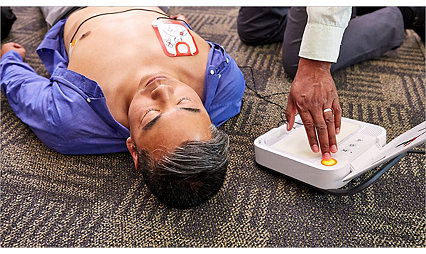Turn urgency into action
When seconds matter, confidence is essential
From the moment a Code Blue alert starts, your team needs to act as one – providing life-saving care with the right devices and data at the right time. Stryker's resuscitation solutions—LIFEPAK 35 monitor/defibrillator, LIFENET System, LIFEPAK CR2 AED and the LUCAS device—help enable efficient critical response by reducing variability1-3 to streamline care and coordination5-7 during emergent events. Because when every moment is critical, you need reliable, easy-to-use5-8 technology so your team can focus on what matters most—your patients.

Bring calm to the chaos
Monitor vital signs while delivering hands-free, high-quality, chest compressions.

Connect people, process and performance
Effective collaboration across teams starts with shared information.

We’re with you at every step
With our solutions, confidence comes from knowing support is within reach.

Respond quickly and confidently
Our resuscitation solutions are designed with code teams in mind. As an emergency responder, you know staffing limitations, time constraints and unit variability highlight the need for consistency across teams. Which is exactly what you need when dealing with an emergent or cardiac event.
When seconds count, you also want to use devices that inspire confidence. While not every device includes each of these clinically advanced features, together our solutions offer your team a powerful set of tools designed to support confident, coordinated care.
- cprINSIGHT1,3
- STJ Insight3
- On-screen prompts3
- Simple voice directions1
- Wi-Fi connectivity1,3,10
- ClearVoice technology1
Products
Emergency medical solutions for lifesaving teams
Our solutions are designed to help you focus on what you do best—save lives. Choose the solution that meets your clinical and operational needs, then deploy quickly with support from a true partner—and a leader in emergency medicine and resuscitation.
LIFEPAK 35 monitor/defibrillator
This future-ready device is designed to promote confident cardiac care and enable clinical excellence in demanding environments.3,11
LUCAS 3, v3.1 chest compression system
Deliver high-performance, continuous chest compressions with less strain and caregiver risk.4,12-14
LIFENET System
This comprehensive cloud-based platform manages and delivers patient information and device data to EMS and hospital teams.2
LIFEPAK CR2 AED
Respond to a cardiac arrest with technology that provides clear and precise instructions at every step of resuscitation.1
Services
A partnership strengthened by trust
Your team deserves a partner – not just a vendor. We share your passion for life-saving care. We understand that every hospital faces unique challenges. Our services are designed to adapt to your needs, giving you confidence that your team is supported today and prepared for tomorrow.
Proactive equipment management
Our ProCare Service offers comprehensive service offerings to provide operational and financial confidence.

Pricing certainty and peace of mind
ALS 360 is an all-inclusive, customizable program that offers fixed payments, technology refresh and convenient asset management for your organization.
Ongoing education and training
We offer educational opportunities to help your team gain knowledge and skills to use our products with confidence.
Shop accessories and disposables
Help keep your staff and patients safe. Our accessories and disposables have been thoroughly tested with our products.
Featured articles
Enhancing pediatric advanced life support: A tool for lifesaving care
The LIFEPAK 35 monitor/defibrillator was designed to support pediatric resuscitation and advanced care, helping clinicians respond with precision in critical moments.
Learn moreUnderstanding the basics of a LUCAS chest compression system
When it comes to medical emergencies like sudden cardiac arrest, time is of the essence. Traditional cardiopulmonary resuscitation (CPR) can be demanding and fatiguing, even for first responders. This is where a LUCAS chest compression system comes into play. The innovative LUCAS device offers a viable solution for consistent, high-quality chest compressions, a critical component in resuscitation.1 This article aims to break down the basics of what a LUCAS chest compression system is and why it is revolutionizing the way CPR is administered.
Learn moreInterested in learning more? Contact an expert.
Have feedback about Stryker’s products and services? Visit our product experience page to connect with us.
M0000014366 REV AA
1. Data on file, Stryker LIFEPAK CR2 OI 3349335-00.
2. Data on file, Stryker LIFENET 3347969_K.
3. Data on file, Stryker OI 3337705-008.
4. Beesems SG, Hardig BM, Nilsson A, Koster RW, Force and depth of mechanical chest compressions and their relation to chest height and gender in an out-of-hospital setting, Resuscitation, 2015;91:67-72.
5. Data on file, Stryker LIFEPAK 35 Human Factors Validation Report, 3338373, Appendix B.
6. Data on file, Stryker LIFENET LCCRD 3349947.
7. Data on file, Stryker LIFENET LCCRD 3347969.
8. Pocock H, Deakin C, Quinn T, et al. Human factors in prehospital research: Lessons from the Paramedic trial. Emergency Medical Journal. 2016;33(8):562-8.
9. Data on file, Stryker CR2 Usability Validation Report 3319528.
10. Data on file, Stryker LUCAS 3 IFU 101034-00 Rev J.
11. Data on file, Stryker SHVR 3338410.
12. Becker L, Zaloshnja E, Levick N, et al. Relative risk of injury and death in ambulances and other emergency vehicles. Accident analysis and prevention. 2003;35(6): 941-48.
13. Jones A, Lee R. Cardiopulmonary resuscitation and back injury in ambulance officers. International Archives of Occupational and Environmental Health. 2005 May;78 (4); 332-36.
14. Edelson, et al. Interim guidance for basic and advanced life support in adults, children, and neonates with suspected or confirmed COVID-19. Circulation. 2020.
AC-GSNPS-SYK-1190955_REV-1_en_us











